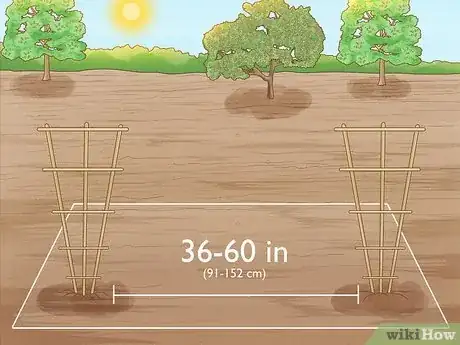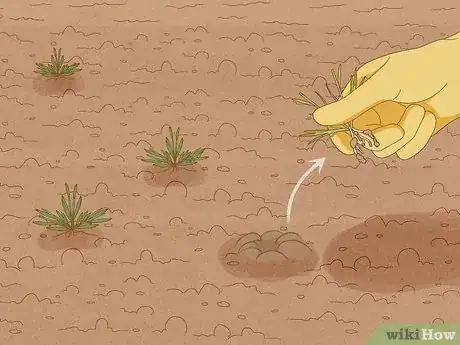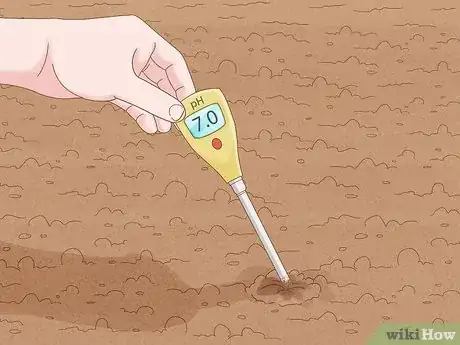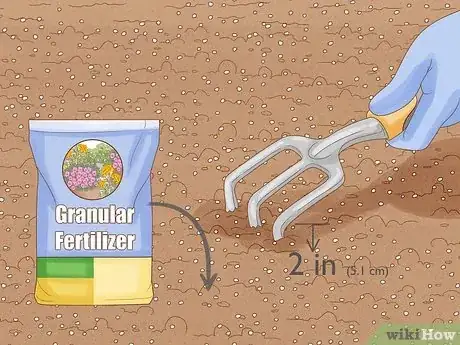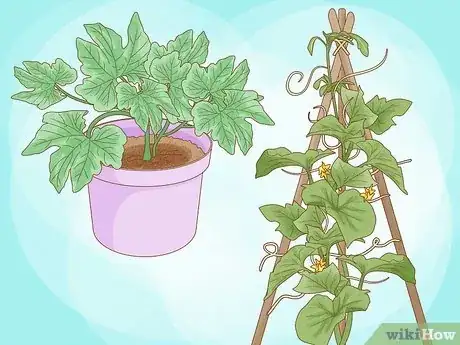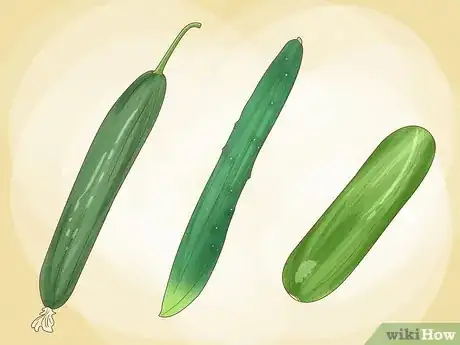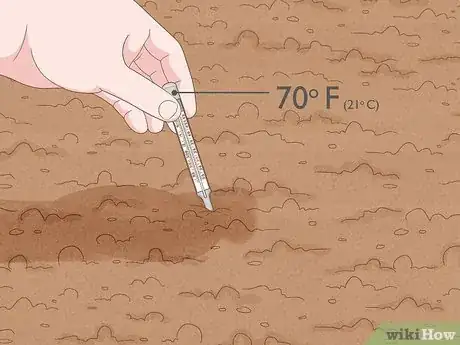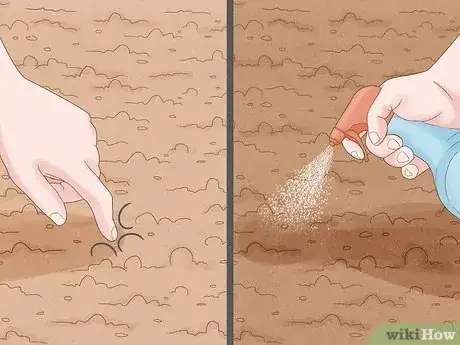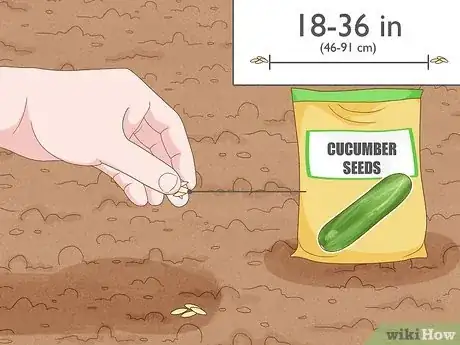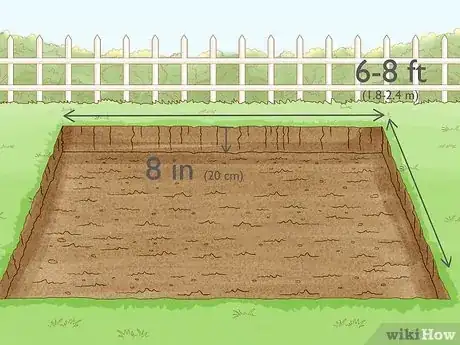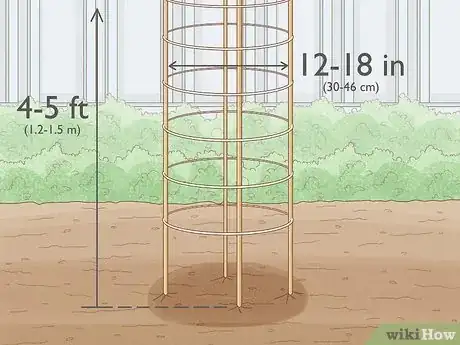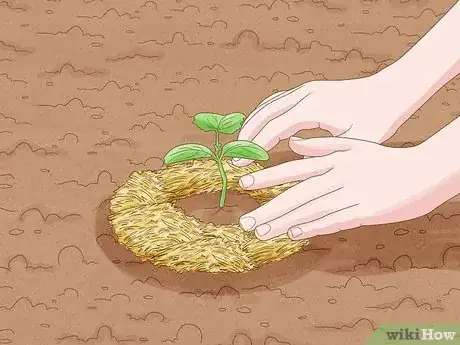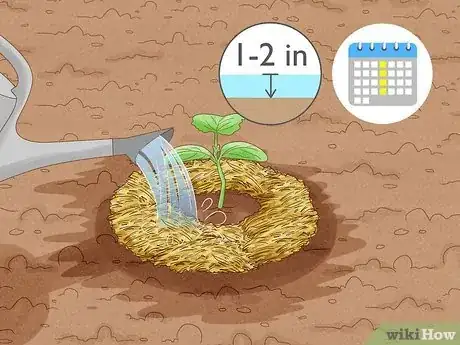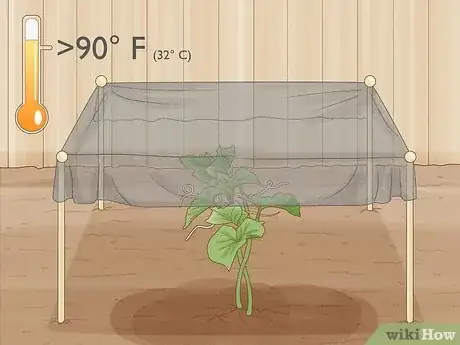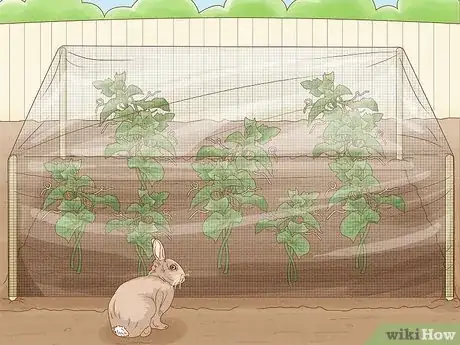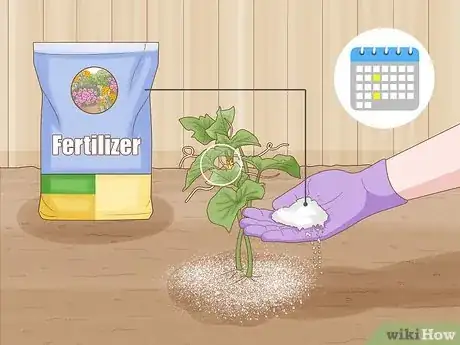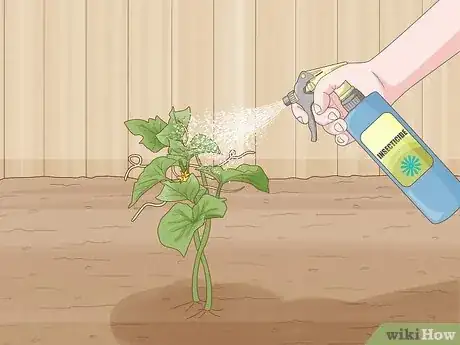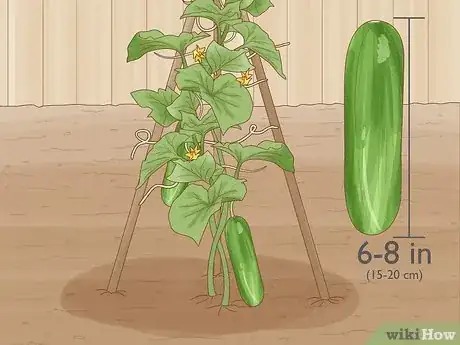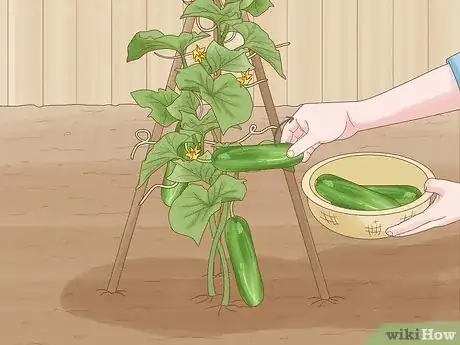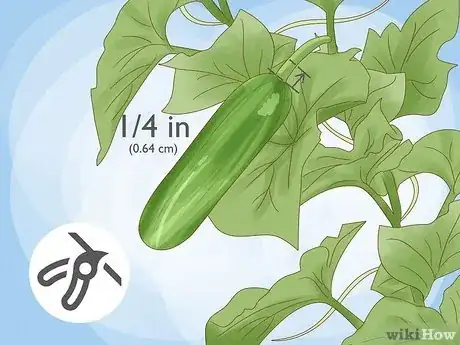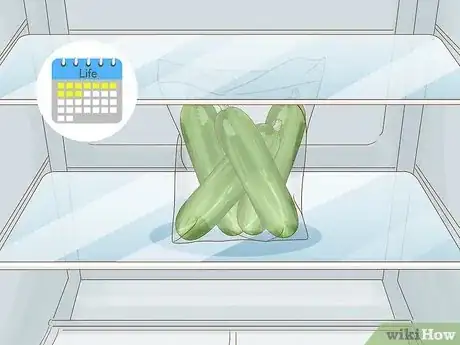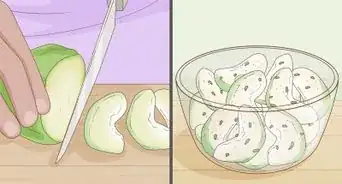This article was co-authored by Maggie Moran and by wikiHow staff writer, Jennifer Mueller, JD. Maggie Moran is a Professional Gardener in Pennsylvania.
wikiHow marks an article as reader-approved once it receives enough positive feedback. In this case, 92% of readers who voted found the article helpful, earning it our reader-approved status.
This article has been viewed 206,408 times.
Cucumbers are high yield plants that are relatively easy to grow in a backyard garden. Bush varieties of this tasty vegetable can even be grown in containers on an apartment porch or balcony. Once you've adequately prepared the soil, all they really need is plenty of water and a lot of sunlight.[1]
Steps
Readying Your Soil
-
1Find a sunny location to plant your cucumbers. Cucumbers are a tropical vegetable, and they crave a lot of direct sunlight. choose a spot where they won't be too shaded from the afternoon sun.
- Cucumbers grow roots 36 to 48 inches (91 to 122 cm) deep, so don't plant them near trees. Tree roots will compete with your cucumber plants for water and nutrition.[2]
- The size of your space will dictate how many plants you can have. You'll want to space vining plants 36 to 60 inches (91 to 152 cm) apart. If you're growing them vertically, allow 12 inches (30 cm) between trellises.
-
2Remove weeds from the area. Cucumbers should be grown in a weed-free area. Weeds will drain nutrients and water from the soil, starving your cucumbers. Small weed cuttings can be left in the soil for fertilizer.[3]
- For best results, pull the weeds up by hand, yanking up as much of the root as possible. If you leave the root of a weed behind, there is a strong likelihood that the same weed will grow back.
- Avoid using herbicides as a shortcut. Both chemical and organic herbicides render the soil unsuitable for overall plant growth, so they'll hurt your cucumbers as well.
Advertisement -
3Bring the soil's pH level as close to 7.0 as possible. Cucumbers thrive in soil with a neutral to slightly alkaline pH. You can buy a pH testing kit at any garden supply center or hardware store.[4]
- Add agricultural lime to increase the pH of your soil. Add sulfur or aluminum sulfate to decrease the pH.
-
4Spread granular fertilizer into the soil. If you're using inorganic fertilizer, the slow-release granular fertilizer will best feed your cucumbers throughout the growth cycle. Use a trowel of a small rake to chop up and loosen the soil before adding fertilizer. This allows the fertilizer to mix into the soil more thoroughly.
- For natural fertilizer, use rich compost or aged manures. Mix them into the soil to a depth of about 2 inches (5.1 cm), then gradually cut and work them into the soil to a depth of 6 to 8 inches (15 to 20 cm).
-
5Add organic material to improve soil quality. The ideal soil for cucumbers is loose, light, and sandy. This type of soil gets warmer more quickly and retains that warmth more easily.[5]
- If you have more clay in your soil, add organic material. Dense, heavy soil can be improved with peat, compost, or rotted manure.
Planting Your Cucumbers
-
1Pick a bush or vine plant. Vine plants are far more common than bush plants. However, if you have limited space, a bush plant may be easier for you to work with. Bush cucumbers can be planted in containers.[6]
- You can still have a vine plant even with limited space. Build or purchase trellises to use and create a vertical garden.
-
2Choose a tasty variety. There are many different varieties of cucumbers. If you're not sure which one to pick, visit a local farmer's market and sample several different varieties until you find your favorite.
- If you're particularly sensitive to bitterness in pickles, try European or Dutch greenhouse varieties, which have a bitter-free gene.
- If cucumbers make you burp, try Asian varieties, which are marketed as being "burp-less." English and Dutch long hothouse cucumbers are also burp-less.
-
3Plant when the soil is at least 70 °F (21 °C). Being tropical plants, cucumbers are exceedingly sensitive to cold temperatures. Wait until at least 2 weeks after the date of the last frost to plant your cucumbers.
- If you want an early crop, start your seeds indoors about 3 weeks before you plan to plant, then transplant the seedlings to your garden.[7]
- In cooler climates, you can warm the soil a few degrees by covering it with black plastic.
- If you find that your area is just not suited to growing cucumbers outdoors, consider growing them inside.
-
4Moisten the soil before seeding. Stick your finger in the soil to check its moisture level before planting. If you feel dry soil up to your first knuckle, water the soil before seeding using a gentle hose or watering can.[8]
- Watering the soil before you plant your seeds reduces the risk that you could wash them away.
-
5Start from a seed. Cucumbers have fragile root systems. It's much easier to seed the garden directly rather than trying to transplant seedlings. Drop 3 or 4 seeds together in a group every 18 to 36 inches (46 to 91 cm).[9]
- Planting several seeds together allows you to select the strongest plant.
- If you are transplanting seedlings, wiggle the entire structure out of the starter pot, soil and all. The soil helps protect the plant's sensitive roots. If you transplant a cucumber bare-rooted, it likely won't survive.
-
6Push seeds slightly into the soil. Cucumber seeds should be no more than 1 inch (2.5 cm) into the soil. You can also lay them on top of the soil, and then cover them over with topsoil of a similar depth.[10]
- Use the flat side of a hoe to tamp down the soil over the seed, but be careful not to pack it.
-
7Give the plants plenty of room. Vining plants, in particular, require a lot of space. Cucumber vines can grow 6 to 8 feet (1.8 to 2.4 m) long. In large gardens, the vines can simply spread over the ground. If you have limited space, you may want fewer plants.
- Cucumber plants that are too crowded can become stressed. The cucumbers won't grow to size and will taste bitter. Production will also decrease. across and about 8 inches (20 cm) deep. The container should also have several drain holes to ensure the best drainage for the plant.”|}}
-
8Set up a trellis. Growing cucumbers vertically increases exposure to sunlight, giving you a higher yield. It also keeps the vegetables cleaner. If you want to grow your cucumbers vertically, go ahead and get your trellises ready before the vines start to grow.
- Use 4 or 5 ft (1.2 or 1.5 m) welded wire fencing or hog wire to create a 12 to 18 in (30 to 46 cm) diameter cage. This size cage can support 2 or 3 vines.
- As your plant gets bigger, you can gently wrap the vine tendrils around the wire to encourage the plant to grow up the trellis.
Caring for Cucumber Plants
-
1Add mulch once seedlings sprout up. Mulch helps prevent the return of weeds, which can deprive your cucumbers of nutrients. It also keeps the soil warm and moist. For additional warmth, use a darker mulch.
- If you're using straw or wood chips, wait until the soil has warmed up to at least 70 °F (21 °C).
-
2Keep your cucumbers well-hydrated. The soil surrounding cucumber plants should be slightly moist at all times. Plan on giving your cucumbers at least 1 to 2 inches (2.5 to 5.1 cm) of water a week to fulfill their hydration needs.
- Be especially vigilant as the plant flowers and begins to fruit. Stress from lack of water can result in bitter-tasting cucumbers.
- Water at the soil level. Wet leaves are at risk of developing powdery mildew. A drip irrigation system can regulate the water flow more constantly, while keeping the foliage dry.[11]
-
3Shade your cucumbers from excess heat. If you live in an area where summer temperatures routinely climb above 90 °F (32 °C), your cucumbers will likely need some shade from the afternoon sun.
- Plant taller crops south of your cucumbers to provide some shade, or use a shade cloth that will block at least 40 percent of the sunlight.
-
4Cover your plants with netting to protect them from wildlife. A fine mesh netting will keep rabbits and chipmunks away. Covering seeds and tiny seedlings with a berry basket keeps them safe from getting dug up by animals.[12]
- Once the plants get larger, you can remove the netting. A fence around your garden would better protect your cucumbers at this stage.
-
5Fertilize again once flowers begin to bud. If you fertilized your soil before seeding, wait until runners appear on the vines and the flowers begin to bud, then add a mild liquid fertilizer or organic feed such as compost or aged manure every 2 weeks.
- If the leaves turn yellow, your plants need more nitrogen. Look for a high-nitrogen fertilizer.
- When using inorganic fertilizer, take care not to get it on any of the plant's leaves or fruits.
-
6Use insecticides or fungicides to combat pests and disease. You can buy both organic and inorganic insecticides and fungicides at your local gardening center. Spray your plants at the first sign of insects or fungus.[13]
- Sulfur has fungicidal properties. However, if you're using sulfur as an organic fungicide, check your soil's pH regularly to make sure it remains in a range suitable for growing cucumbers.
- Read and follow directions on any insecticides carefully. Even organic insecticides can be dangerous if used incorrectly.
Harvesting Your Cucumbers
-
1Pick your cucumbers at the optimal size. For higher production, you don't want to leave your cucumbers on the vine too long or allow them to get too big. The best size at which to harvest your cucumbers depends on the variety you've planted.
- Generally, Middle Eastern or Mediterranean cucumbers are shorter and thicker than American varieties. In contrast, Asian varieties typically are long and slender.
- American slicers generally should be 6 to 8 inches (15 to 20 cm) long. Middle Eastern varieties are best at 4 to 6 inches (10 to 15 cm), while picklers should be harvested at 3 to 5 inches (7.6 to 12.7 cm).
-
2Pick cucumbers often. Generally speaking, the more frequently you pick cucumbers, the more cucumbers the plant will grow. Check your plants every day and pick the cucumbers that are around optimal size for their variety.
- While picking your cucumbers, check for weeds and inspect your plants for signs of any insects or disease. You should also check the soil and water as necessary. Cucumbers need plenty of water throughout their growth cycle.
-
3Use pruning shears to pick cucumbers cleanly. Take hold of the cucumber, then cut the stem about 1⁄4 inch (0.64 cm) above the end. Many people think they can simply pull or twist a cucumber off a vine. However, when you do this you risk damaging the vine.
-
4Refrigerate your cucumbers to keep them crisp. Try to use your cucumbers as soon as possible after you harvest them for the best flavor and texture. If necessary, you can keep them in the refrigerator for 7 to 10 days.
- Wrap them in plastic or put them in a zippered plastic bag before refrigerating them to keep them from drying out.
Expert Q&A
Did you know you can get expert answers for this article?
Unlock expert answers by supporting wikiHow
-
QuestionWhat month should I plant cucumbers?
 Maggie MoranMaggie Moran is a Professional Gardener in Pennsylvania.
Maggie MoranMaggie Moran is a Professional Gardener in Pennsylvania.
Home & Garden Specialist
-
QuestionHow much sun do you need to grow cucumbers?
 Maggie MoranMaggie Moran is a Professional Gardener in Pennsylvania.
Maggie MoranMaggie Moran is a Professional Gardener in Pennsylvania.
Home & Garden Specialist
-
QuestionHow many cucumbers can you get from one plant?
 Maggie MoranMaggie Moran is a Professional Gardener in Pennsylvania.
Maggie MoranMaggie Moran is a Professional Gardener in Pennsylvania.
Home & Garden Specialist
References
- ↑ https://www.almanac.com/plant/cucumbers
- ↑ https://agrilifeextension.tamu.edu/browse/featured-solutions/gardening-landscaping/cucumbers/
- ↑ https://agrilifeextension.tamu.edu/browse/featured-solutions/gardening-landscaping/cucumbers/
- ↑ https://www.almanac.com/plant/cucumbers
- ↑ https://www.almanac.com/plant/cucumbers
- ↑ https://www.almanac.com/plant/cucumbers
- ↑ https://www.almanac.com/plant/cucumbers
- ↑ https://www.almanac.com/plant/cucumbers
- ↑ https://agrilifeextension.tamu.edu/browse/featured-solutions/gardening-landscaping/cucumbers/
- ↑ https://agrilifeextension.tamu.edu/browse/featured-solutions/gardening-landscaping/cucumbers/
- ↑ https://www.almanac.com/plant/cucumbers
- ↑ http://www.almanac.com/plant/cucumbers
- ↑ https://agrilifeextension.tamu.edu/browse/featured-solutions/gardening-landscaping/cucumbers/
- ↑ https://www.almanac.com/plant/cucumbers
- ↑ https://agrilifeextension.tamu.edu/browse/featured-solutions/gardening-landscaping/cucumbers/
About This Article
To grow cucumbers, look for a growing spot that gets plenty of full sun and has loose, sandy soil. Then, plant your cucumbers by pushing a group of 3 to 4 cucumber seeds into about 1 inch of moist soil, making sure that the groups are about 18 to 36 inches apart. When the cucumbers sprout, give them about 1 inch of water per week and add a trellis for their vines to attach onto to help them reach more sunlight. When your cucumber flowers begin to bud, fertilize them with nitrogen-rich fertilizer every 2 weeks to keep plants healthy. For more tips from our Horticultural reviewer, like how to harvest cucumbers, read on!
